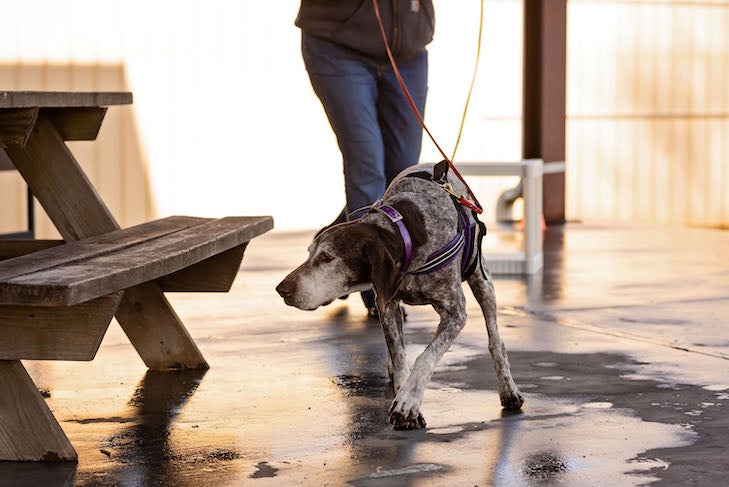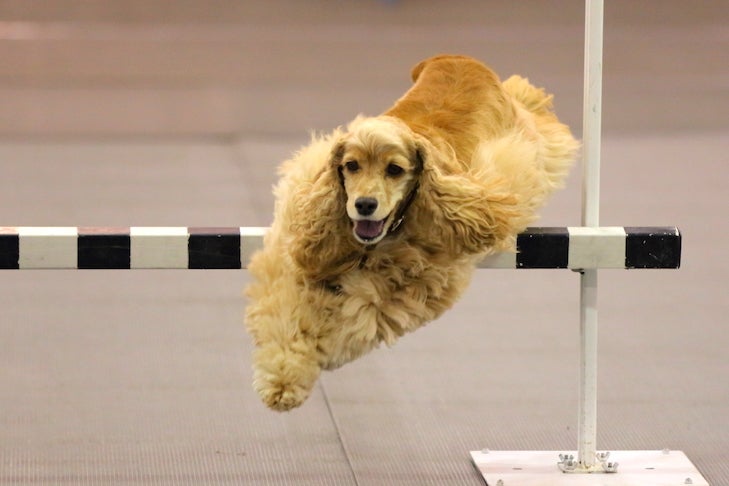Could the dog lying beside you on the couch actually be an athlete in the making?
If you start researching how to get involved in dog sports, you’ll often see lots of young dogs training, so you might feel like you’re behind if you have an older dog. But the great thing about dog sports is that they’re very welcoming and accessible to dogs of any age. In fact, the majority of dogs who compete in sports at the national level are senior dogs (7 and older).
Ready to get started? Here are some great ways to introduce your older dog to the world of dog sports.
Start Basic
Contrary to the old saying, you absolutely can teach an old dog new tricks, and you absolutely should. Our dogs thrive on interaction with us. Dogs love to play and learn new things and it’s never too late to start. So instead of just sitting on the couch or putting your dog in the backyard, spend some quality time brushing up on basic manners and obedience, teach a new trick, or even sign yourselves up for an introductory class at your local dog training facility. You can start by earning your Virtual Home Manners title.
Talk to Your Vet
If you have an adult dog, or a senior dog who has been fairly sedentary for a while, it’s always a good idea to schedule an appointment with a veterinarian before beginning training. Discuss the activities that you are planning to get involved with, and gather information from your vet about activities to avoid or be careful with.

Build Motivation
If your dog has spent most of their life going on occasional walks but not otherwise doing much, you may want to start by building their desire to learn and engage with you. Begin with activities and rewards you know your dog likes or is interested in. If you aren’t sure what kinds of treats your dog likes, it’s helpful to experiment with different options. The goal is to find treats that will be “high value,” meaning your dog doesn’t just like the treat but loves it. Use these treats when practicing new skills and teaching something new to build motivation for training and learning.
Regardless of what activity, sport, or skill you and your dog are beginning to explore, keep your training sessions short and fun. Learning is hard work mentally, and potentially physically as well. Your dog will need to build up attention span and endurance for training. Be sure to end each training session on a positive note. The idea is that you don’t want to be drilling skills over and over again. Instead, leave each training session with your dog wanting more—not feeling tired or overwhelmed.
Develop Drive
It’s essential to build drive (also known as engagement) and excitement for training. Some dogs will have more or less drive naturally but it’s also something that can be developed in any dog. If your dog likes toys, it’s great to bring playing with toys into your training sessions. Use the chance to play ball as a reward when teaching new skills. Ask for a cue your dog already knows and then throw the toy or release your dog to tug on the toy. Chase and tug games incorporated into training can be very helpful with building engagement and focus, as well as overall drive and enthusiasm for working with you.

Make Everyday Activities Fun
Another fun and easy way to start to build drive, engagement, and learning is to turn everyday activities into engaging training sessions. Instead of just putting your dog’s food in a bowl and walking away, you can start to incorporate training activities into mealtime. To start making meals more exciting as you are preparing your dog’s breakfast or dinner, cue a few tricks your dog already knows and reward with part of the meal or put the bowl down. By using your dog’s meal to work on new tricks or skills, you’ll be building training routines into your day, and build your dog’s enthusiasm for learning.
Get Started in Sports
Have you watched dog sports on TV or online and wished you and your dog could be out there having fun together? You can! The wonderful thing about dog sports is that there really is a sport/activity out there for just about every dog and handler. A great first step is to train your dog for the new Virtual Home Manners and/or the Canine Good Citizen Test. These are appropriate for adult dogs who are in need of a bit of a refresher on basic obedience, which will be useful in any sport you pursue, and a good entry point into training and competing with your dog.
Once you’re ready, find the best sport for you and your dog. Reach out to local clubs, attend events, find a mentor, and have fun.

